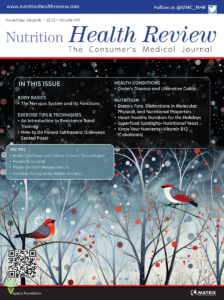 The fall months offer nutrient-dense produce aplenty! The wholesome cruciferous and root vegetables and ripe fruits of the season are packed with vitamins to help your immune system both welcome the cold and combat the germs that follow. Learn more about these nourishing crops below!
The fall months offer nutrient-dense produce aplenty! The wholesome cruciferous and root vegetables and ripe fruits of the season are packed with vitamins to help your immune system both welcome the cold and combat the germs that follow. Learn more about these nourishing crops below!
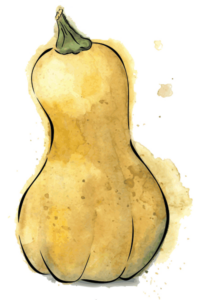 Butternut Squash
Butternut Squash
Though considered a winter squash, this classified fruit is harvested during the fall months. Beta-carotene, beta-cryptoxanthin, and alpha-carotene are compounds, known as carotenoids, that provide butternut squash with its orange-yellow pigment.1 While in the body, these compounds transform the vitamin A content of the squash into retinal and retinoic acid (the active forms of vitamin A), which moderate cell growth and immune function and maintain eye and bone health.2,3 In fact, a single cup of cooked butternut squash harnesses an estimated 450 percent of the daily recommended amount for vitamin A. Additionally, its vitamin E content has been shown to reduce rates of age-related diseases, such as dementia or Alzheimer’s 4 disease. B vitamins, like folate and B6 for energy and the formation of red cells, can also be found in this winter squash.1
Cabbage
Low in calories but high in nutrients, cabbage is a nutritional powerhouse full of vitamins K, B6, C, and A.5 This cruciferous vegetable also contains folate, which, along with B6, is essential for energy metabolism and greatly influences the nervous system.6 The high dose of vitamin C is beneficial for cardiovascular disease and cancer protection, too.7 An ideal source of fiber and mighty antioxidants, cabbage shields the body from free radicals that might lead to inflammation and cell damage.5
Tip: Go for the most vibrant red or purple cabbage—it contains approximately more than eight times the number of antioxidants than green!8
Cauliflower
Another cruciferous vegetable that’s high in fiber, a cup of cauliflower contains 10 percent of the daily recommended amount. 9 Additionally, cauliflower is chock full of vitamin C and choline, an essential nutrient responsible for cell integrity maintenance, the creation of neurotransmitters optimal for brain health, and prevention of fat accumulation in the liver. 10 Moreover, an increased risk of cardiovascular and neurodegenerative diseases has been correlated to a choline deficiency. Ample amounts of sulforaphane, an antioxidant that subdues the development of cancer and cancer growth, can be found in cauliflower as well.11
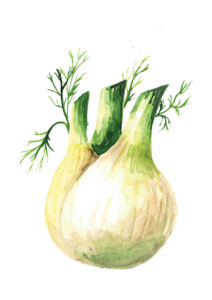 Fennel
Fennel
A plant with antioxidant, anti- inflammatory, and antibacterial properties, fennel bulbs and seeds have been utilized for its medicinal abilities, aiding in digestion and soothing stomach and colon muscles.12 Fennel is also loaded with
nutrients that enhance immune health and blood sugar regulation, improve cellular tissue repair and protection, stimulate the production of collagen, and activate throughout the body.13
According to a study published in Food Chemistry, fennel can hinder bacterial and yeast advancement in the body, such as infections related to Escherichia coli, Staphylococcus aureus, and Candida albicans. 14 Researchers also suggest that, similar to its effects on the colon, fennel can relieve menstrual and menopausal symptoms by calming hot flashes, cramps, vagina itching, and sleep disturbances. 15 Please note that though fennel is beneficial and safe for those menstruating or menopausal, the estrogen-like effects might interfere with fetal development. 16 Consumption of fennel or use of fennel oil while pregnant should be discussed with and monitored by a healthcare provider.
 Figs
Figs
Fresh figs are an excellent source of copper, an essential nutrient that cofactors enzymes (known as cuproenzymes) that impact the production of energy, how iron is metabolized, and the compounding of connective tissue throughout the body and neurotransmitters. The cuproenzymes in copper are also responsible for many physiologic functions, such as brain development, gene expression modulation, and function of the immune system.17
This mildly sweet fruit also contains high amounts of fiber and vitamin B6, which assists in dietary protein breakdown and the creation of novel protein in the body.18 In addition to regulating digestive health, figs have the ability to improve cardiovascular health by lowering blood pressure and higher lipid levels.19
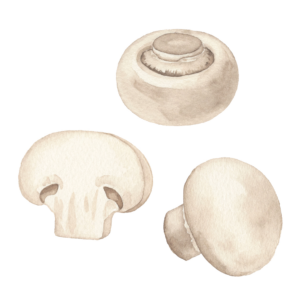 Mushrooms
Mushrooms
Though about 50,000 species of mushrooms that have been classified, researchers suggest that is only a small fraction of what is currently growing on this planet.20 Generally, edible forms of these fungi, like shitake and maitake, have exhibited medicinal benefits throughout history.21 The fall months tend to produce mushrooms with a variety of textures and flavors. Some that are commonly harvested in the fall include oyster (Pleurotus ostreatus), honey/ “button” (Armillariella mellea), and hen of the woods (Grifola frondosa).22 Mushrooms are best known for their anti-inflammatory, anticancer, and antioxidant properties.
Plant components and chemicals found in mushrooms prompt the activation of immune cells that can interrupt and even stop the growth and spread of cancer cells, which ultimately results in tumor cell death.21 According to Harvard’s T.H. Chan School of Public Health, many polysaccharides that are in mushrooms have shown cancer-fighting abilities as well.21
Onions
Alongside the superfood garlic, as well as shallots, chives, and leeks, onions are of the Allium genus of flowering plants—all of which have demonstrated tremendous overall health effects. Like its flowering comrades, onions contain plant compounds that combat inflammation and oxidants.23 The anti-inflammatory and antioxidant power of onions can reduce blood pressure, offer blood clot prevention, and decrease LDL (“bad”) cholesterol levels.23,24 Red onions have anthocyanins, a type of flavonoid that provide produce their vibrant red, purple, and blue pigments. In particular, anthocyanins play a large role in cancer prevention and improvement of visual and neurological health. To boot, anthocyanins also contain antimicrobial properties that can stop growth of harmful bacteria, including H. pylori, a type of bacterium correlated to stomach ulcers and come colon cancers, and Methicillin- resistant Staphylococcus aureus, also known as MRSA or a staph infection.25,26
 Bell Peppers
Bell Peppers
Overall, this fruit contains high amounts of vitamins C, A, B6, and K1. In fact, one medium-sized bell pepper offers 169 percent of the daily recommended amount of vitamin C;27 moreover, because the
vitamin C content is so great, it tends to amplify the absorption of iron once consumed, thus, reducing the risk of anemia, a condition that consists of the bloodstream lacking the red blood cells to transport oxygen to cells throughout the body.28
Available in a variety of colors, red, orange, yellow, and green, each color holds different compounds that perform various functions. For example, the capsanthin in red peppers are a powerful antioxidant that is also responsible for its redness.29 Lutein is typically found in green peppers, and consumption has been correlated to better eye health.30 The carotenoid, violaxanthin, found in yellow and orange peppers are another potent antioxidant.31 All variances of peppers are composed of quercetin, an antioxidant that can prevent certain cancers and heart disease development.32,33
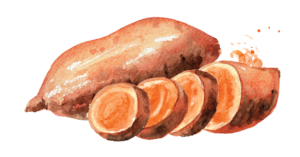 Sweet Potatoes
Sweet Potatoes
An edible root, the orange flesh of sweet potato is rich in beta-carotene, and the purple flesh of purple sweet potatoes are rich in anthocyanins. Both are phytochemicals found in plants that provide vegetables and fruits their vibrant pigments and many health benefits, primarily serving as an antioxidant.34 Sweet potatoes are also high in beta-carotene, vitamins B6 and C, potassium, and magnesium.34,35 Just one serving (200 grams) of sweet potato provides an estimated 400 percent of the recommended daily amount of vitamin A (from beta-carotene) and a third of the daily recommended amount of magnesium.36 Along with its antioxidant and immune system function effects, can moderate blood-glucose levels, and the potassium also located in its skin regulates fluid balance, muscle contractions, and nerve signals.34 The best way to prepare a sweet potato is to boil it. This will increase the bioactivity of all its wonderful nutrients.38
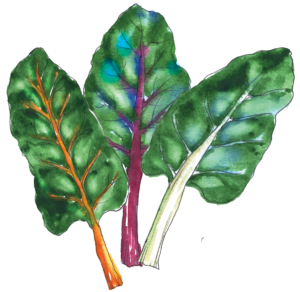 Swiss Chard
Swiss Chard
This dark, leafy vegetable contains an abundance of polyphenols (antioxidants) and flavonoids that protect the body from cell tissue damage and reduce the risk of many chronic diseases. It is also an excellent source of kaempferol, a mighty anti-inflammatory compound. To boot, Swiss chard is full of vitamin K1, a fat-soluble nutrient that modulates cellular functions and provides the proteins necessary for blood clotting. One cup of cooked chard has approximately 716 percent of the daily recommended amount of vitamin K1.41 The vitamin K found in Swiss chard also ensures bones in the body form osteocalcin, a protein involved in bone maintenance.42,43 Other high levels of nutrients found in kale include vitamins A,C, and E.
SOURCES
- Harvard T.H. Chan School of Public Health site. Winter Squash. The Nutrition Source. https://www.hsph.harvard.edu/nutritionsource/food-features/winter-squash/. Accessed 30 Sept 2020.
- Colorado State University site. Vitamin A (Retinol). VIVO Pathophysiology. http://www.vivo.colostate.edu/hbooks/pathphys/topics/vitamina.html. Accessed 30 Sept 2020.
- Gilbert C. What is vitamin A and why do we need it?. Community Eye Health. 2013;26(84):65.
- Rizvi S, Raza ST, Ahmed F, et al. The role of vitamin e in human health and some diseases. Sultan Qaboos Univ Med J. 2014;14(2):e157–e165.
- Harvard T.H. Chan School of Public Health site. Vitamin B6. The Nutrition Source. https://www.hsph.harvard.edu/nutritionsource/vitamin-b6/.
Accessed 30 Sept 2020. - Rokayya S, Li CJ, Zhao Y, Li Y, Sun CH. Cabbage (Brassica oleracea L. var. capitata) phytochemicals with antioxidant and anti-inflammatory potential. Asian Pac J Cancer Prev. 14(11):6657–6662
- National Institutes of Health site. Vitamin C. Updated Fed 27 2020. https://ods.od.nih.gov/factsheets/VitaminC-HealthProfessional/. Accessed 30 Sept 2020.
- NutritionFacts.Org site. Cabbage. https://nutritionfacts.org/topics/cabbage/. Accessed 30 Sept 2020.
- NutritionData site. Cauliflower, Raw, Nutrition Facts and Calories. https://nutritiondata.self.com/facts/vegetables-and-vegetable-products/2390/2. Accessed 30 Sept 2020.
- Zeisel SH, da Costa KA. Choline: An essential nutrient for public health. Nutr Rev. 2009;67(11):615–623.
- Tortorella SM, Royce SG, Licciardi PV, Karagiannis TC. Dietary sulforaphane in cancer chemoprevention: The role of epigenetic regulation and HDAC inhibition. Antioxid Redox Signal. 2015;22(16):1382–1424.
- The Northwest School for Botanical Studies site. Fennel. 5 Dec 2013. Herb Education. http://www.herbaleducation.net/fennel. Accessed 30 Sept 2020.
- Figueroa-Méndez R, Rivas-Arancibia S. Vitamin C in health and disease: Its role in the metabolism of cells and redox state in the brain. Front Physiol. 2015;6:397.
- Salami M, Rahimmalek M, Ehtemam MH. Inhibitory effect of different fennel (Foeniculum vulgare) samples and their phenolic compounds on formation of advanced glycation products and comparison of antimicrobial and antioxidant activities. Food Chem. 2016;15;213:196–205.
- Khadivzadeh T, Najafi MN, Kargarfard L, et al. Effect of fennel on the health status of menopausal women: A systematic and meta-analysis. J Menopausal Med. 2018;24(1):67–74.
- Ostad SN, Khakinegad B, Sabzevari O. Evaluation of the teratogenicity of fennel essential oil (FEO) on the rat embryo limb buds culture. Toxicol In Vitro. 2004;18(5):623–627.
- National Institutes of Health site. Copper. Updated 3 Jun 2020. https://ods.od.nih.gov/factsheets/Copper-HealthProfessional. Accessed 30 Sept 2020.
- 18) National Institutes of Health site. Vitamin B6. Updated 24 Feb 2020. https://ods.od.nih.gov/factsheets/VitaminB6-HealthProfessional/. Accessed 30 Sept 2020.
- Alamgeer, Iman S, Asif H, Saleem M. Evaluation of antihypertensive potential of Ficus carica fruit. Pharm Biol. 2017;55(1):1047–1053.
- Visual Dictionary site. Edible Mushrooms: A Treat You Shouldn’t Fear! http://www.ikonet.com/en/visualdictionary/static/us/edible_mushrooms. Accessed 30 Sept 2020.
- Harvard T.H. Chan School of Public Health. Mushrooms. The Nutrition Source. https://www.hsph.harvard.edu/nutritionsource/food-features/mushrooms/. Accessed 30 Sept 2020.
- Davenport L. Mushroom Foraging in the Fall. Oct 1991. https://www.motherearthnews.com/nature-and-environment/mushroom-foraging-zm0z91zsie. Accessed 30 Sept 2020.
- Vazquez-Prieto MA, Rodriguez Lanzi C, Lembo C, et al. Garlic and onion attenuates vascular inflammation and oxidative stress in fructose-fed rats. J Nutr Metab. 2011;2011:475216.
- Brüll V, Burak C, Stoffel-Wagner B, et al. Effects of a quercetin-rich onion skin extract on 24 h ambulatory blood pressure and endothelial function in overweight-to-obese patients with (pre-)hypertension: A randomised double-blinded placebo-controlled cross-over trial. Br J Nutr. 2015;114(8):126 –1277.
- Khoo HE, Azlan A, Tang ST, Lim SM. Anthocyanidins and anthocyanins: Colored pigments as food, pharmaceutical ingredients, and the potential health benefits. Food Nutr Res. 2017;61(1):1361779.
- Ramos FA, Takaishi Y, Shirotori M, et al. Antibacterial and antioxidant activities of quercetin oxidation products from yellow onion (Allium cepa) skin. J Agric Food Chem. 2006;54(10):3551–3557.
- United States Department of Agriculture site. Pepper, Raw, NFS. 1 Apr 2020.https://ndb.nal.usda.gov/fdc-app.html#/food-details/787810/nutrients. Accessed 30 Sept 2020.
- Thankachan P, Walczyk T, Muthayya S, et al. Iron absorption in young Indian women: The interaction of iron status with the influence of tea and ascorbic acid. Am J Clin Nutr. 2008;87(4):881–886.
- Kim S, Ha TY, Hwanf KI. Analysis, bioavailability, and potential healthy effects of capsanthin, natural red pigment from Capsicum spp. Food Reviews International. 2009;25(3):198–213.
- Abdel-Aal el-SM, Akhtar H, Zaheer K, Ali R. Dietary sources of lutein and zeaxanthin carotenoids and their role in eye health. Nutrients. 2013;5(4):1169–1185.
- Gómez-García M del R, Ochoa-Alejo N. Biochemistry and molecular biology of carotenoid biosynthesis in chili peppers (Capsicum spp.). Int J Mol Sci. 2013;14(9):19025–19053.
- Lin Y, Yngve A, Lagergren J, Lu Y. A dietary pattern rich in lignans, quercetin and resveratrol decreases the risk of oesophageal cancer. Br J Nutr. 2014;112(12):2002–2009.
- Larson AJ, Symons JD, Jalili T. Therapeutic potential of quercetin to decrease blood pressure: Review of efficacy and mechanisms. Adv Nutr. 2012;3(1):39–46.
- Harvard T.H. Chan School of Health site. Sweet Potatoes.The Nutrition Source. https://www.hsph.harvard.edu/nutritionsource/food-features/sweet-potatoes/. Accessed 30 Sept 2020.
- Shortsleeve C. Are Sweet Potatoes Healthy? 10 Jan 2019. https://time.com/5498125/are-sweet-potatoes-healthy/. Time. Accessed 30 Sept 2020.
- United States Department of Agriculture site. Sweet Potato. 1 Apr 2019. https://ndb.nal.usda.gov/fdc-app.html#/food-details/478350/nutrients. Accessed 30 Sept 2020.
- National Institutes of Health site. Vitamin A. Updated 14 Feb 2020. https://ods.od.nih.gov/factsheets/VitaminA-HealthProfessional/. Accessed 30 Sept 2020.
- Greger M. The Best Way to Cook Sweet Potatoes. 7 Jul 2014. https://nutritionfacts.org/video/the-best-way-to-cook-sweet-potatoes/. Accessed 30 Sept 2020.
- Pyo Y, Lee T, Logendra L, Rosen RT. Antioxidant activity and phenolic compounds of Swiss chard (Beta vulgaris subspecies cycla) extracts. Food chemistry. 2004;85: 19–26.
- National Institutes of Health site. Vitamin K. Updated 3 Jun 2020. https://ods.od.nih.gov/factsheets/VitaminK-HealthProfessional/. Accessed 30 Sept 2020.
- NutritionData site. Chard, Swiss, Cooked, Boiled, Drained Without Salt Nutrition Facts and Calories. https://nutritiondata.self.com/facts/vegetables-and-vegetable-products/2400/2. Accessed 30 Sept 2020.
- Gundberg CM, Lian JB, Booth SL. Vitamin K-dependent carboxylation of osteocalcin: Friend or foe?. Adv Nutr. 2012;3(2):149–157.
- Vermeer C. Vitamin K: the effect on health beyond coagulation – an overview. Food Nutr Res. 2012;56:10.3402/fnr.v56i0.5329.




